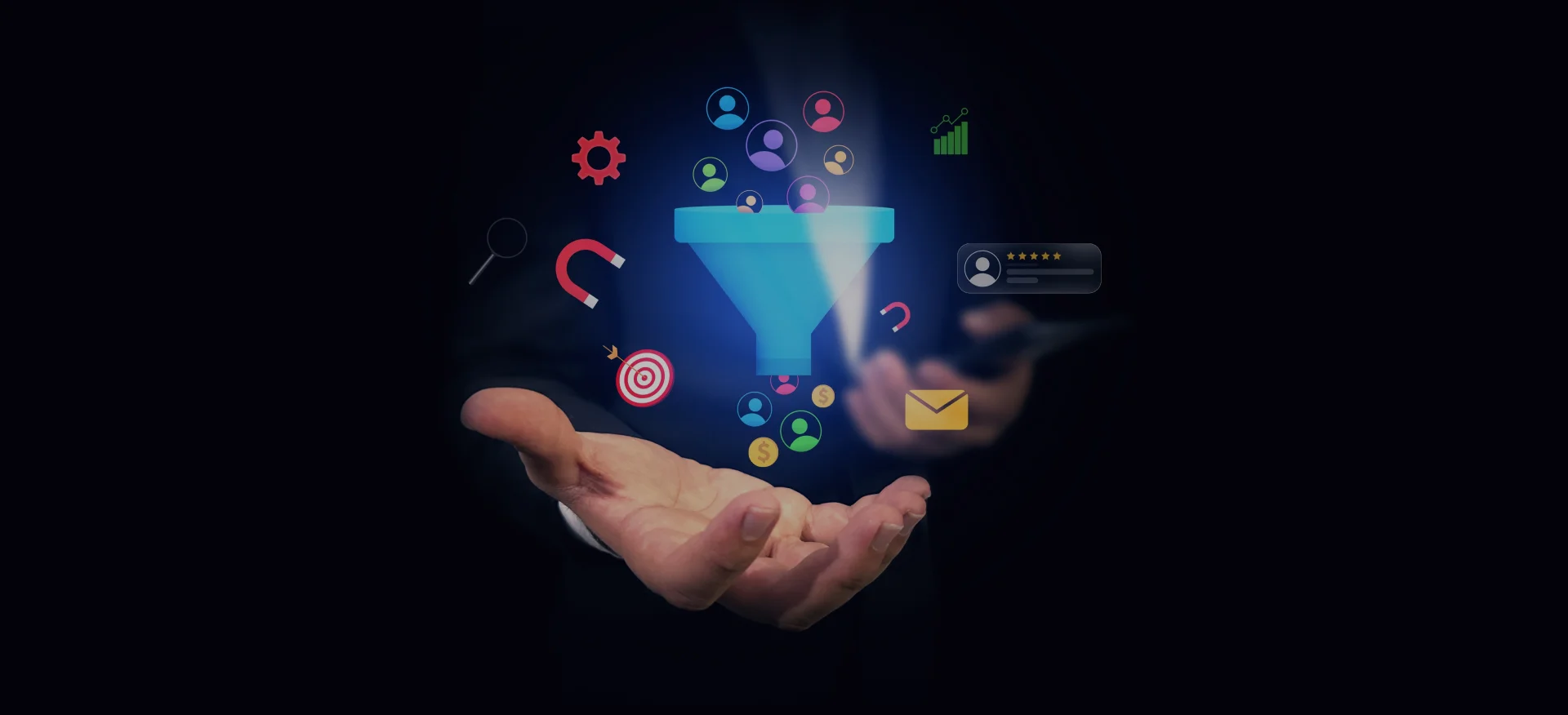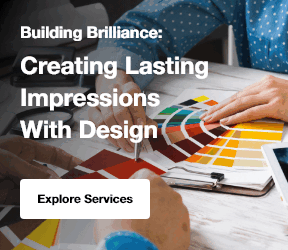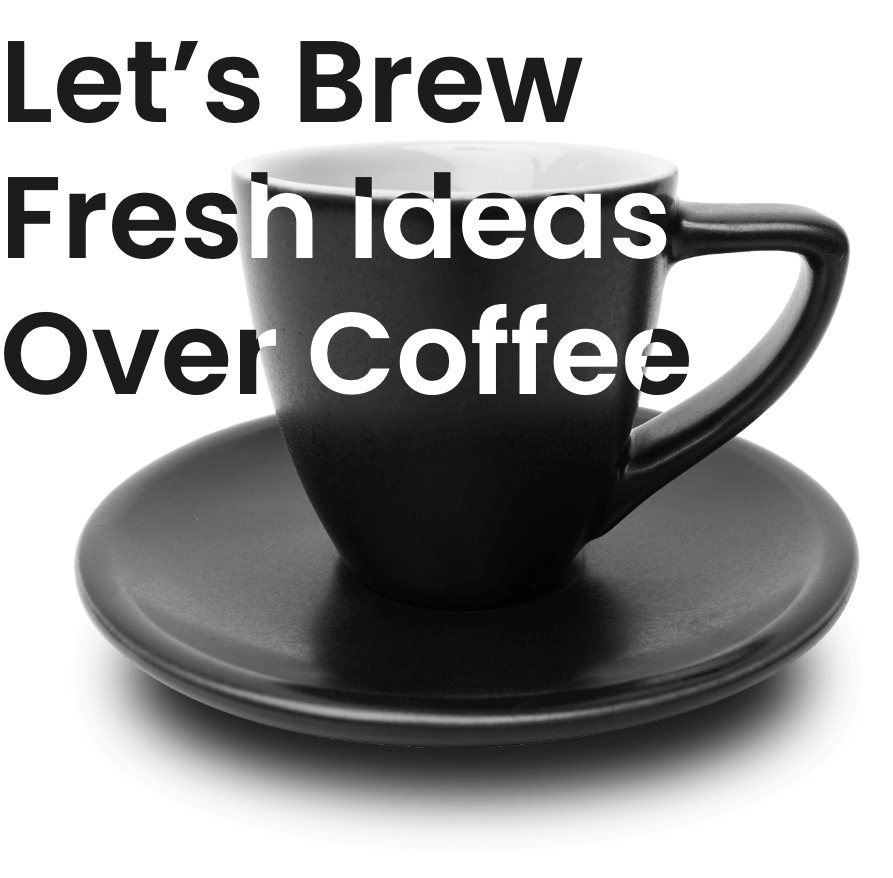Building a lead generation funnel is a game-changer for any business looking to attract and convert potential customers. It’s like a roadmap that helps guide people from the first time they hear about your brand to the moment they make a purchase and beyond.
The process begins when someone discovers your brand. Maybe they found you through content marketing, SEO, or even a paid ad. This is the awareness stage, where they just start to learn about what you offer.
Next, they move into the interest stage, where you engage them with resources like eBooks, webinars, or useful guides that offer more value and get them excited about what you have to offer.
As they move to the consideration stage, it’s time to dive deeper. Share things like case studies, testimonials, or product demos that build trust and make them feel confident about your brand.
Finally, at the conversion stage, it’s all about closing the deal. You can do this with things like irresistible calls-to-action, limited-time discounts, or exclusive offers that push them to take action.
This guide will walk you through each step of the lead generation funnel, showing you how to nurture prospects at every stage and turn them into loyal, paying customers.
What is a Lead?
A lead is a potential customer who has shown interest in your product, service, or business. This interest could come in many forms, such as filling out a contact form, signing up for a newsletter, downloading an eBook, or interacting with your brand on social media.
What is a Lead Generation Funnel?
A lead generation funnel is a structured process that guides potential customers through several stages, from initial awareness to becoming loyal customers. If you’re wondering what is B2B lead generation, it’s essentially the same process tailored for businesses that sell to other businesses rather than individual consumers.
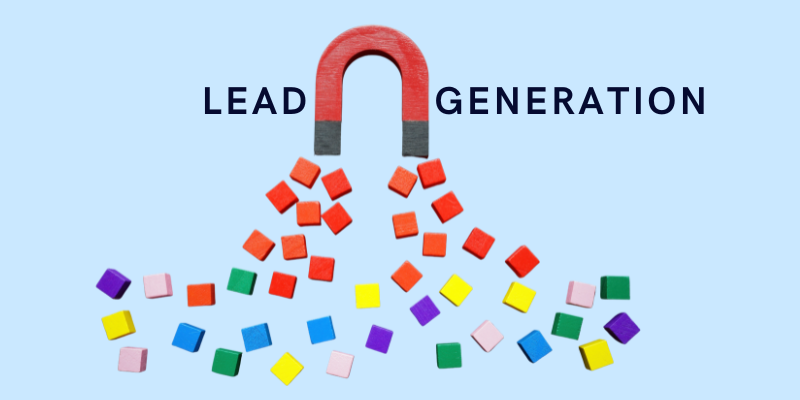
The funnel focuses on attracting leads, nurturing them, and ultimately converting them into paying customers.
Each stage of the funnel is designed to engage prospects with relevant content and solutions that match their needs, moving them closer to making a purchase.
6 Stages of Lead Generation Funnel
The lead generation funnel outlines the journey prospects take from first discovering your brand to becoming loyal customers.
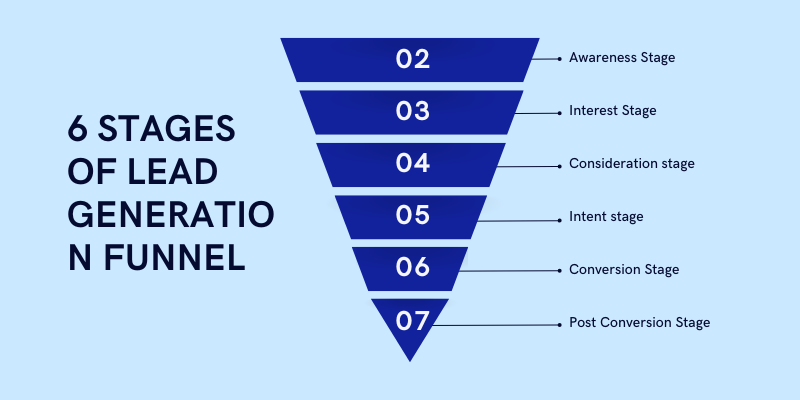
The 6 stages of a lead generation funnel typically include
- Awareness Stage
- Interest Stage
- Consideration stage
- Intent stage
- Conversion Stage
- Post Conversion Stage
Let’s explore each stage.
1. Awareness Stage
The Awareness Stage is the first phase in the lead generation funnel, where potential customers become aware of your brand, product, or service.
At this point, they may not yet recognize their need for a solution, but they are beginning to identify a problem or opportunity.
Here are the key strategies for this stage:
- Educational Content: Create blog posts, videos, or infographics that address common problems or questions in your industry.
- SEO Optimization: Ensure your content ranks well in search engines by using tools like SEO ranking report software to monitor keyword performance and identify new opportunities to reach a broader audience.
- Social Media Engagement: Share valuable content on platforms where your target audience is active.
- Paid Advertising: Use targeted ads to increase visibility among potential leads.
Remember, the goal of the awareness stage is to build brand recognition and trust. By providing valuable information, you position your brand as a helpful resource, guiding prospects toward the next stage of the funnel.
Metrics to track in the awareness stage:
- Website Traffic: How many people are visiting your website or landing pages.
- Social Media Engagement: Likes, shares, comments, and follows on your social media platforms.
- Content Reach: How many people are engaging with or sharing your content.
- Brand Impressions: How often your brand is seen, whether through ads, search, or content shares.
The awareness stage sets the foundation for moving prospects further down the funnel. Once you’ve captured their attention and piqued their interest, you can guide them into the next stage, Interest.
2. Interest Stage
The Interest Stage is the second phase in the lead generation funnel, following the initial awareness of your brand.
At this point, potential customers have recognized a need or problem and are actively seeking information to address it.
They are aware of your brand and want to learn more about what you offer. The goal here is to transform curiosity into genuine interest by providing valuable, relevant content that resonates with their specific needs.
Here are the key strategies for this stage:
- Educational Content: Offer in-depth articles, guides, and blog posts that delve into topics of interest to your audience.
- Webinars and Demos: Host live sessions or demonstrations to showcase your expertise and the value of your product or service.
- Email Campaigns: Send targeted emails with valuable information, updates, and resources to keep prospects engaged.
- Case Studies and Testimonials: Share success stories and testimonials to build credibility and trust.
Here are the common mistakes to avoid:
- Overly Promotional Content: Focusing too much on selling can turn off potential leads.
- Neglecting SEO: Without proper optimization, and tracking your Google keyword ranking, your content may not reach those searching for it.
- Ignoring Audience Needs: Failing to address the actual problems or questions of your audience can lead to disengagement.
The interest stage is crucial for nurturing leads and guiding them toward the next phase of the funnel. By providing valuable and relevant information, you can build a relationship with your prospects, positioning your brand as a trusted authority in your field.
Explore Our Digital Marketing Services!
3. Consideration Stage
In the Consideration Stage, leads have shown interest in your business and are actively evaluating your products or services. The goal here is to build trust and demonstrate why your solution is the best choice.
They are actively seeking solutions and comparing options, making this a critical time to nurture their interest and guide them toward conversion.
Here are the key strategies for this stage:
- Offer Valuable Content: Provide in-depth resources like whitepapers, case studies, and product comparisons to assist prospects in their evaluation process.
- Implement Lead Scoring: Assign scores to leads based on their engagement and fit, allowing for prioritized follow-ups.
- Personalize Communication: Tailor emails and content to address the specific needs and interests of each lead, especially in B2B marketing where relationship-building and personalization are key.
- Use Retargeting Ads: Display targeted ads to visitors who have engaged with your site but haven't converted, keeping your brand top-of-mind.
- Optimize Landing Pages: Ensure landing pages are aligned with the content and offers that brought visitors there, while making sure your site performs well across the top search engines, providing a seamless experience.
Metrics to track in the conversion stage:
- Lead Conversion Rate: Measures the percentage of visitors who become leads after engaging with your content or offers.
- Landing Page Conversion Rate: Tracks how well your landing pages turn visitors into leads.
- CTA (Call-to-Action) Performance: Evaluates the effectiveness of your CTAs in prompting user action.
- Lead Source Attribution: Identifies which channels (e.g., organic search, paid ads, social media) are most effective in generating leads.
- Time on Site: Indicates how long visitors stay on your site, reflecting content relevance.
- Pages per Session: Shows how many pages a visitor views, suggesting content depth.
- Bounce Rate: Percentage of visitors who leave after viewing only one page; a lower rate suggests better engagement.
- Cost Per Lead (CPL): Calculates the average cost to acquire a lead through various marketing efforts.
By closely monitoring these metrics and implementing targeted strategies, you can effectively guide prospects through the consideration stage, increasing the likelihood of conversion in the subsequent stages of the funnel.
4. Intent Stage
In the Intent Stage, leads are demonstrating clear signs of interest and are considering making a purchase. The focus now is on identifying high-quality leads who are most likely to convert and providing them with the final push toward a purchase decision.
At this juncture, prospects are actively evaluating solutions and are primed for decisive actions.
Here are the key strategies for this stage:
- Personalized Outreach: Tailor communications to address the specific needs and concerns of the prospect, demonstrating a deep understanding of their challenges.
- Exclusive Offers: Provide limited-time discounts, free trials, or bundled services to incentivize immediate action.
- Retargeting Campaigns: Utilize ads to re-engage prospects who have shown interest but haven't yet converted, keeping your brand top-of-mind.
- Clear Calls to Action (CTAs): Ensure that your CTAs are compelling and straightforward, guiding prospects toward the next step in their journey.
Metrics to track in the intent stage:
- Lead Conversion Rate: The percentage of leads that take a desired action, such as signing up for a trial or requesting a demo.
- Engagement Metrics: Tracking interactions like video views, content downloads, and webinar attendance to gauge interest levels.
- Time to Conversion: The average duration it takes for a lead to move from the Intent Stage to the next phase, indicating the efficiency of your nurturing process.
- Sales Qualified Leads (SQLs): The number of leads that meet specific criteria set by the sales team, signaling a high likelihood of conversion.
By effectively identifying and nurturing leads in the intent stage, businesses can significantly enhance their conversion rates and strengthen their B2B sales funnel for sustained growth.
5. Conversion Stage
The Conversion Stage is where all your efforts in earlier stages pay off. At this point, leads are ready to make a purchase, and the goal is to turn them into paying customers.
This stage focuses on providing a clear and compelling reason for leads to take action immediately.
Here are the key strategies for this stage:
- Streamline the Checkout Process: Simplify forms and reduce the number of steps to make the process quicker and more user-friendly.
- Offer Limited-Time Discounts: Create urgency with time-sensitive offers to encourage immediate action.
- Provide Multiple Payment Options: Cater to different preferences by offering various payment methods. Many Digital marketing Services providers use flexible billing and automation to streamline this process for their clients.
- Use Clear and Compelling Calls to Action (CTAs): Ensure CTAs are prominent and persuasive, guiding users toward conversion.
- Leverage Social Proof: Display testimonials, reviews, or case studies to build trust and credibility.
Metrics to track in the conversion stage:
- Conversion Rate: Percentage of visitors completing desired actions (e.g., purchase, sign-up). Higher rates show effective strategies.
- Abandonment Rate: Percentage of users who start but don't complete conversions (e.g., cart abandonment). Addressing this can improve conversions.
- Lead-to-Customer Ratio: Proportion of leads turning into customers. A higher ratio indicates efficient lead nurturing.
- Average Order Value (AOV): Average spend per transaction. Increasing AOV boosts revenue without acquiring new customers.
- Customer Acquisition Cost (CAC): Cost to acquire a new customer. Lower CAC with quality leads reflects effective marketing and sales.
By focusing on these metrics and strategies, businesses can effectively guide prospects through the Conversion Stage, turning interest into tangible outcomes and driving revenue growth.
6. Post-Conversion Stage
The post-conversion stage is the phase following a customer's initial purchase or sign-up.
While often overlooked, this stage is crucial for fostering long-term relationships, increasing customer lifetime value (LTV), and turning satisfied customers into brand advocates.
Here are the key strategies for this stage:
- Personalized Follow-Ups: Send tailored emails or messages thanking customers and offering relevant product recommendations.
- Exclusive Offers: Provide loyalty discounts, early access to new products, or special promotions to encourage repeat business.
- Customer Support Excellence: Ensure responsive and helpful customer service to resolve any issues promptly.
- Engagement through Content: Share valuable content, such as how-to guides, user stories, or product tips, to keep customers engaged.
- Referral Programs: Encourage satisfied customers to refer friends and family by offering incentives.
Metrics to track in the post-conversion stage:
- Repeat Purchase Rate: Percentage of customers who make more than one purchase.
- Customer Satisfaction Score (CSAT): Direct feedback from customers about their experience.
- Net Promoter Score (NPS): Measures customer loyalty and likelihood to recommend your brand.
- Customer Retention Rate: Percentage of customers retained over a specific period.
- Churn Rate: Percentage of customers lost over a specific period.
By focusing on the post-conversion stage, businesses can not only retain customers but also turn them into loyal advocates who contribute to sustained growth and success.
7 Tips to Optimize Lead generation Funnel
Optimizing your lead generation funnel involves refining each stage to engage prospects effectively, boost conversions, and enhance overall performance.
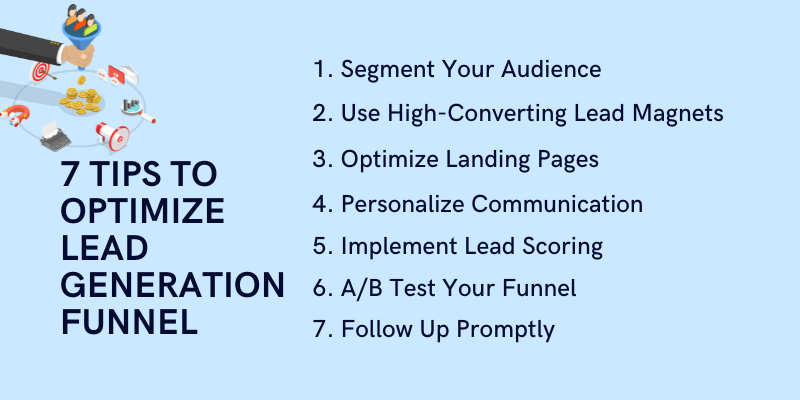
Here are some tips you can consider:
1. Segment Your Audience
Tailor your messaging and offers based on the unique needs of different customer segments. For instance, the Best Lead Generation For Realtors might differ from what works for tech companies, so adjust strategies accordingly. This will make your funnel more relevant and increase engagement at every stage.
2. Use High-Converting Lead Magnets
Offer valuable resources such as eBooks, case studies, or webinars in exchange for contact information. Consider using some of the Best Lead Generation Tools to create, automate, and manage these lead magnets effectively. Ensure your lead magnets address your audience's pain points to attract high-quality leads.
3. Optimize Landing Pages
Design clean, user-friendly landing pages with clear, compelling calls-to-action (CTAs). Ensure these pages are mobile-responsive, fast-loading, and aligned with the content that brought users there
4. Personalize Communication
Personalize email and ad campaigns by addressing the lead by name and providing content tailored to their interests or behaviors. This builds trust and increases the chances of conversion.
5. Implement Lead Scoring
Use lead scoring to prioritize leads based on their level of engagement and likelihood to convert. Focus on high-scoring leads to optimize your sales efforts and resources.
6. A/B Test Your Funnel
Regularly test elements of your funnel, such as CTAs, landing pages, email subject lines, and ad copy. Use the results to make data-driven adjustments and improve conversion rates.
7. Follow Up Promptly
Respond to leads quickly with timely follow-ups. Automated email sequences or retargeting ads can help you engage leads who haven’t yet converted, keeping your brand top of mind.
Conclusion
Understanding how to improve your lead generation funnel is key for businesses that want to boost conversions and grow over time. By focusing on each part of the funnel, from getting attention to keeping customers happy, you can guide your leads smoothly through the process, offering them the right content and deals at every step. Starting with the Awareness stage, it’s all about attracting the right people with helpful content. Then, the Interest and Consideration stages help nurture those leads through personalized communication and solutions that fit their needs.
When it’s time for the Conversion stage, strong calls-to-action and tempting offers are crucial to push leads to take action. After they’ve converted, don’t forget about retention and referrals, keeping your customers happy and encouraging them to spread the word. To keep improving, track how well your funnel is working with analytics, A/B testing, and feedback. This helps you find areas to tweak and make sure your lead generation strategies stay effective. For expert support in optimizing your funnel, Centric, a trusted provider of digital marketing solutions, can help you implement data-driven strategies that convert.
